DIFFUSE DISEASES of CONNECTIVE TISSUE (DDCT) Definition

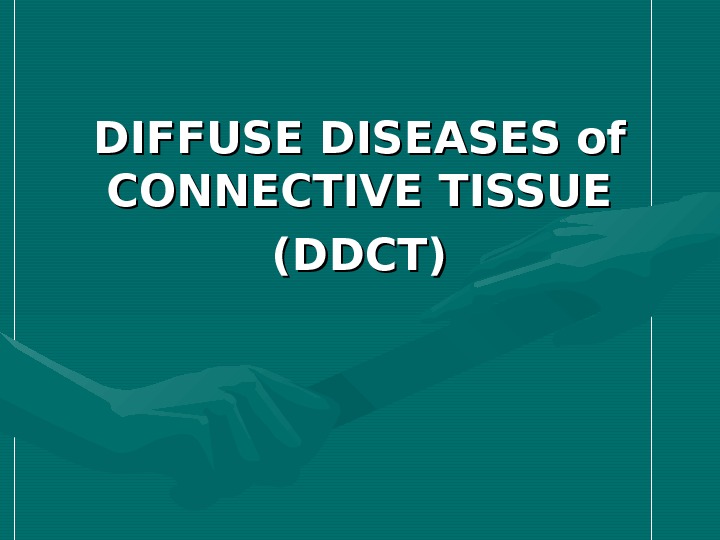
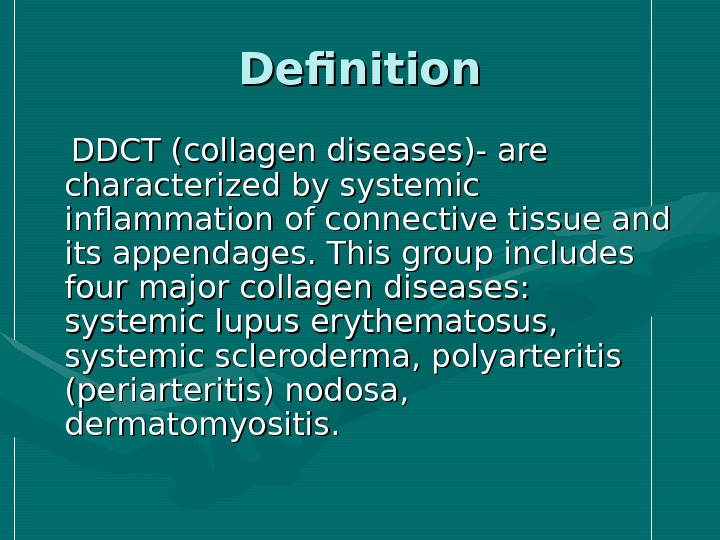

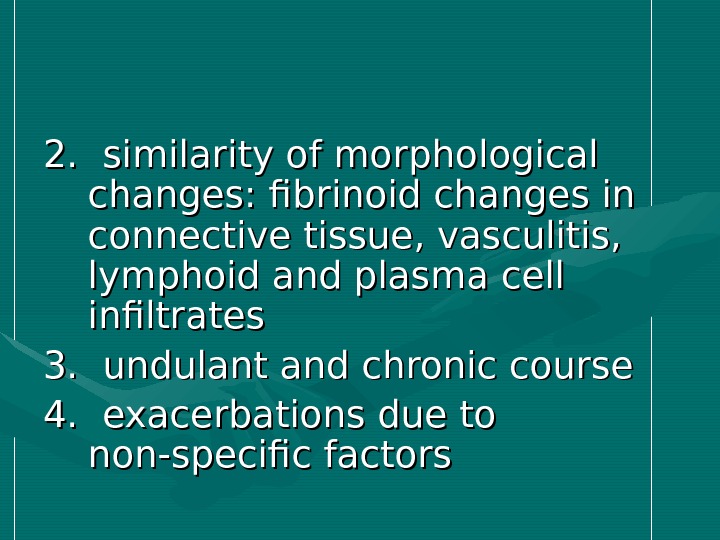
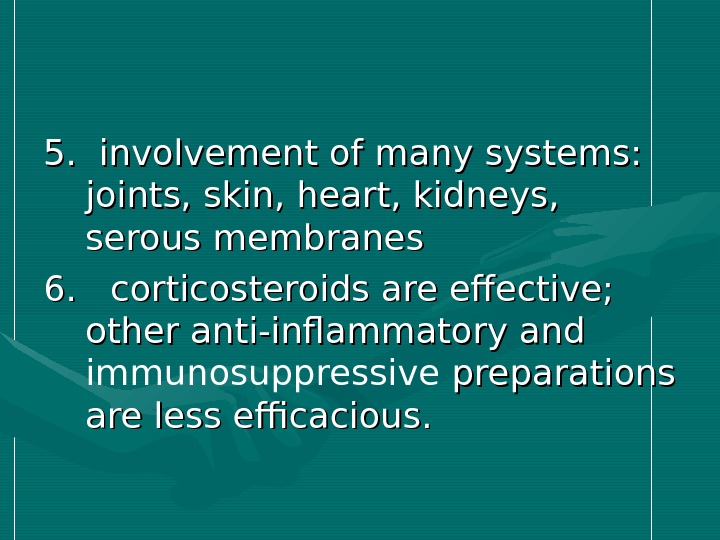
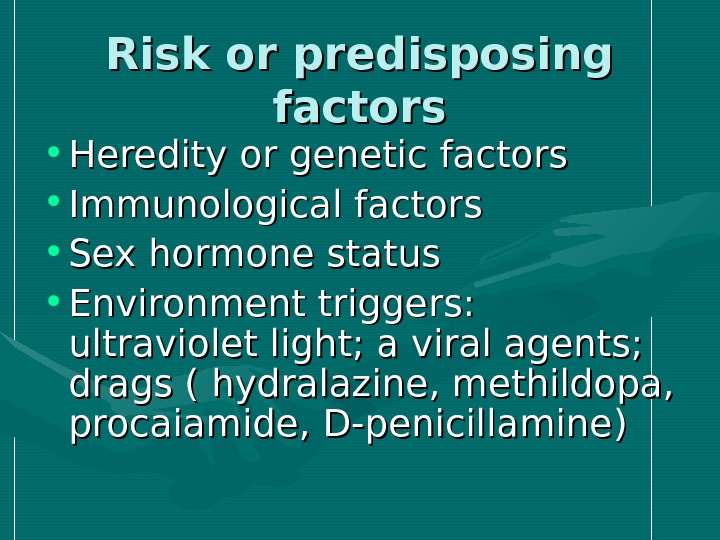
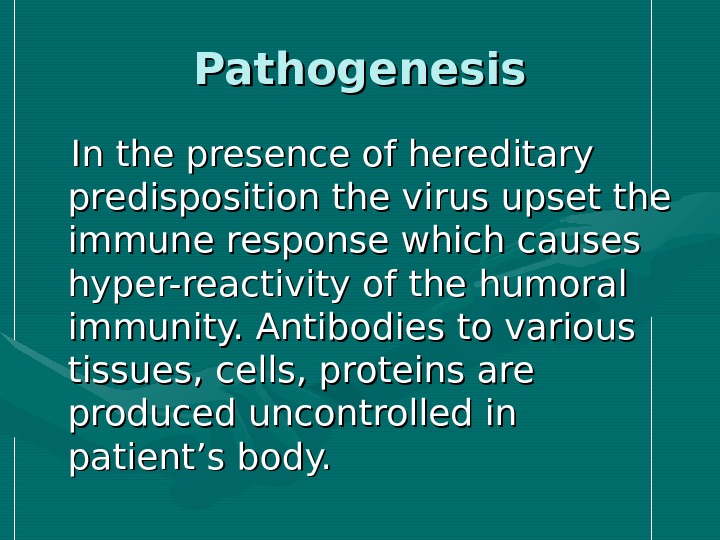

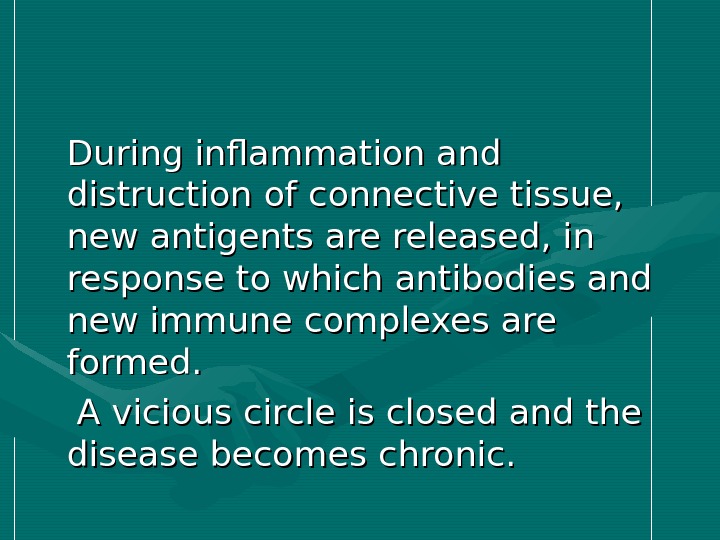
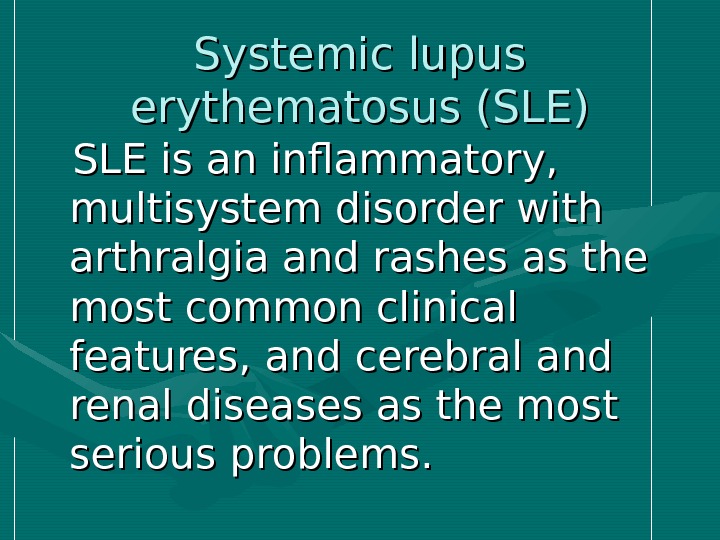
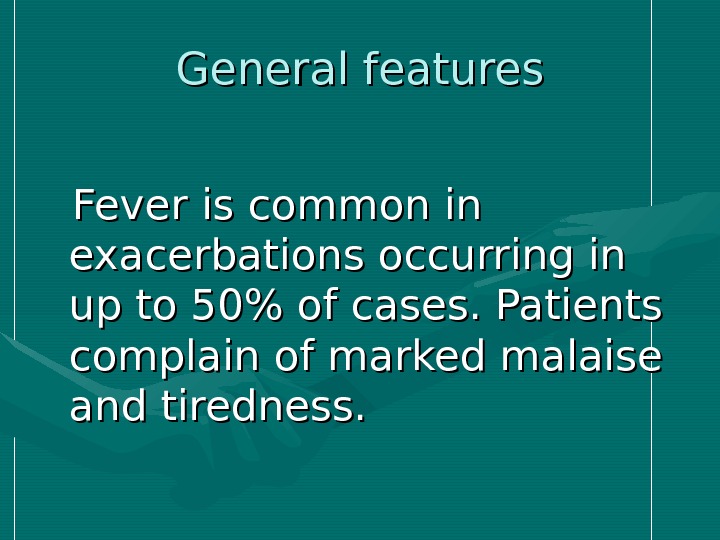
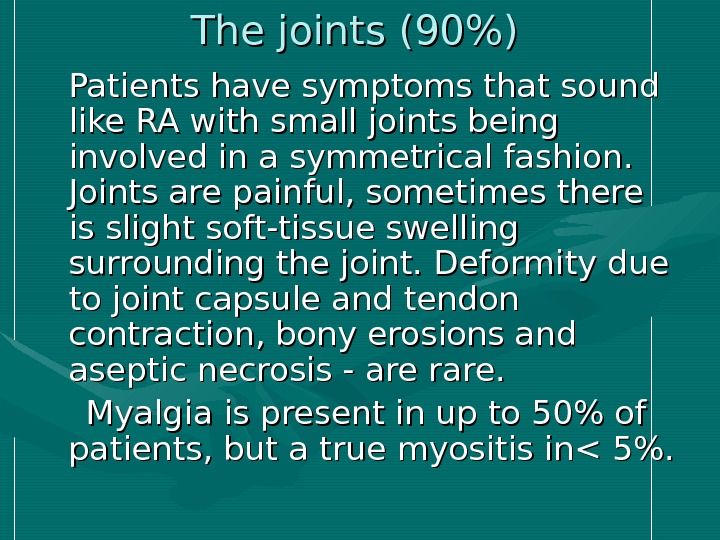


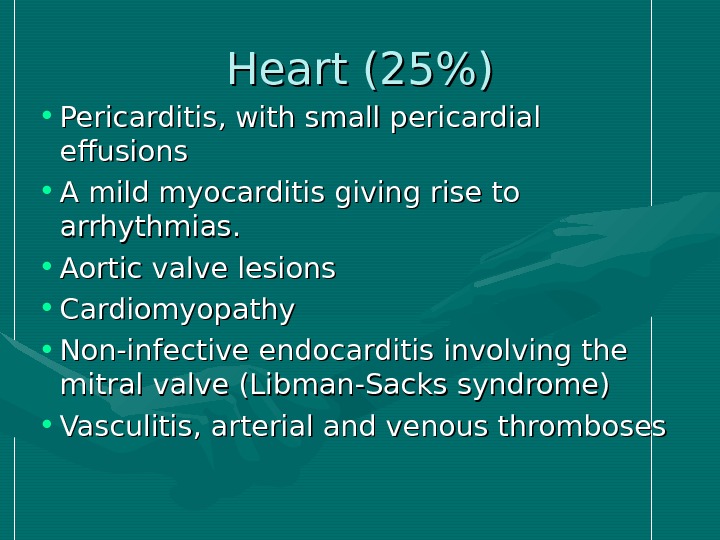
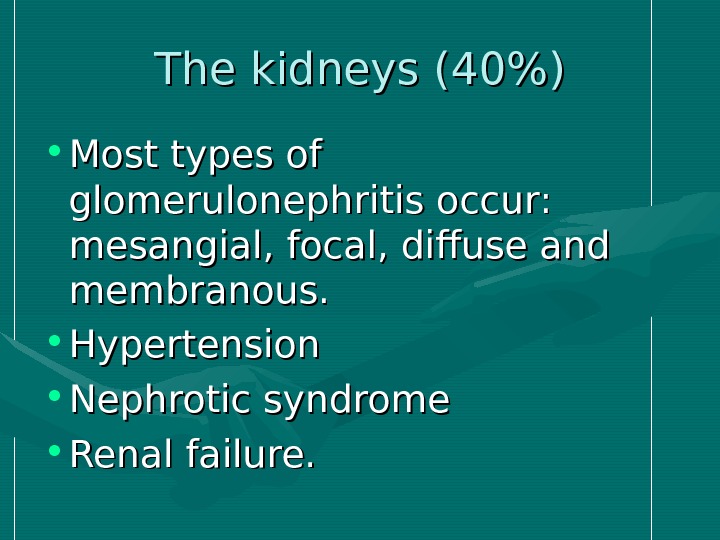
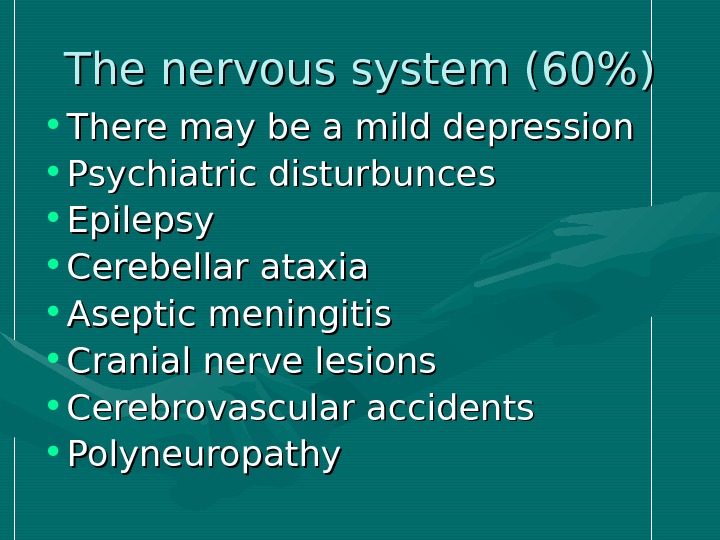
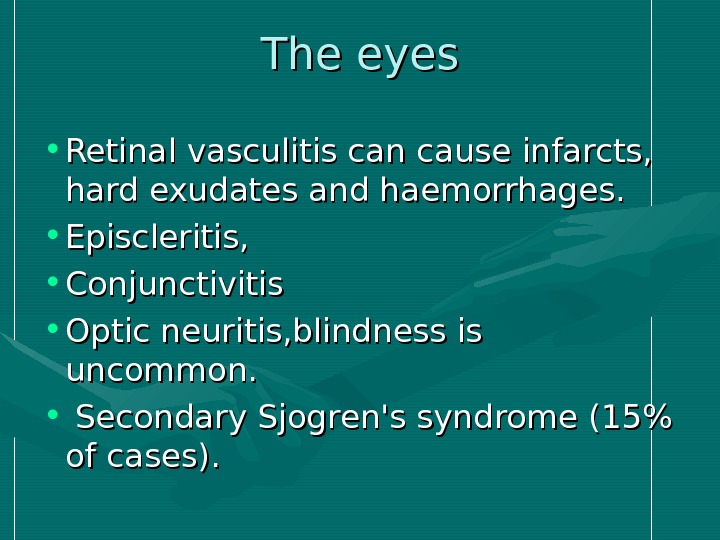
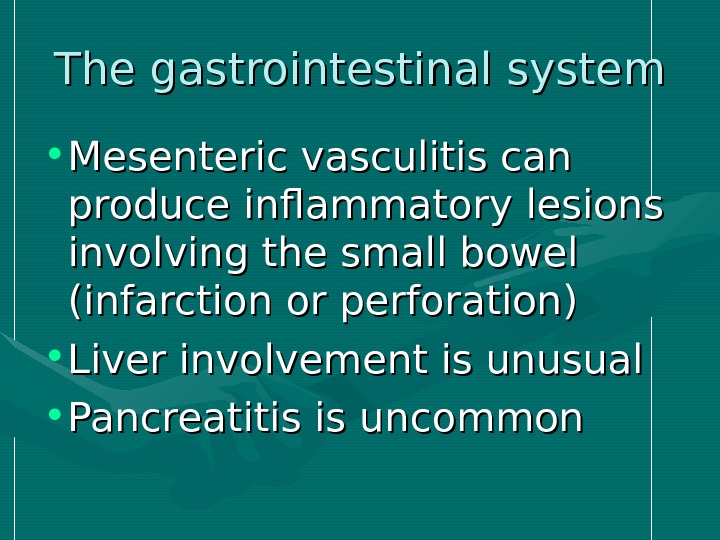
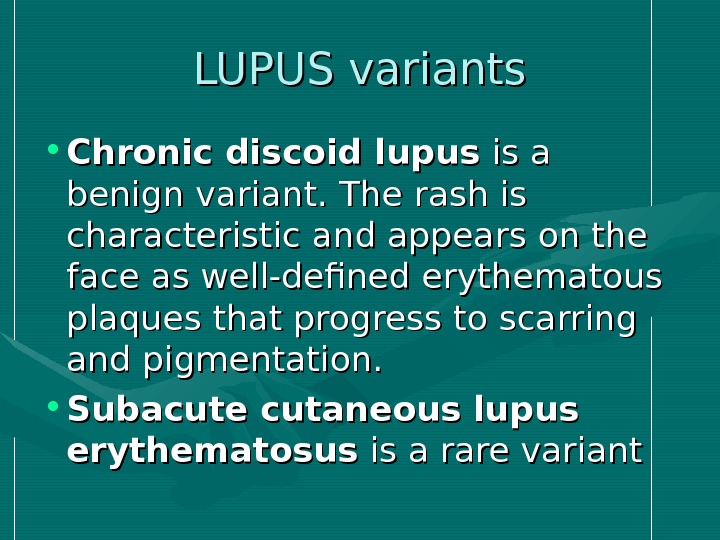
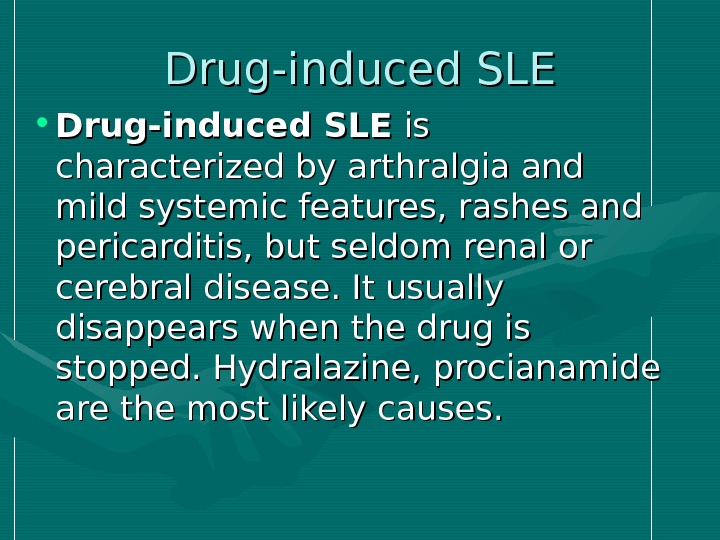
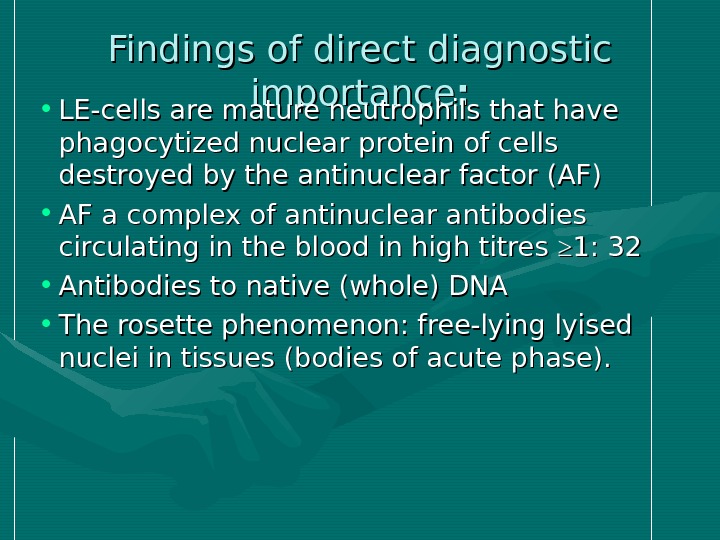
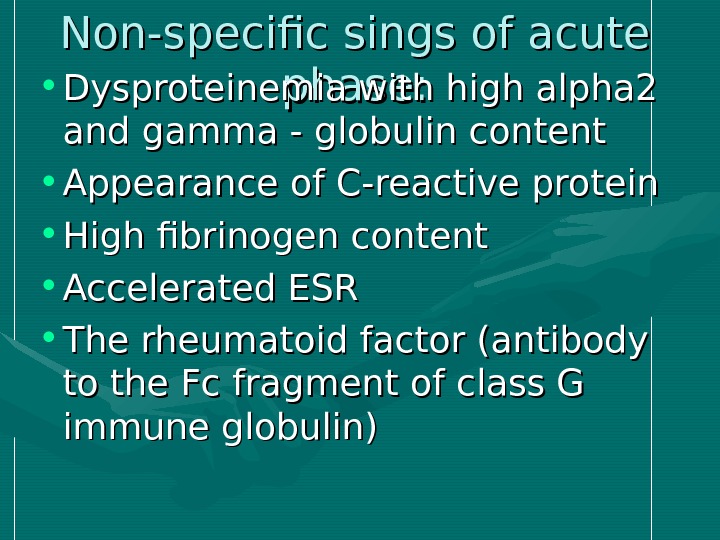
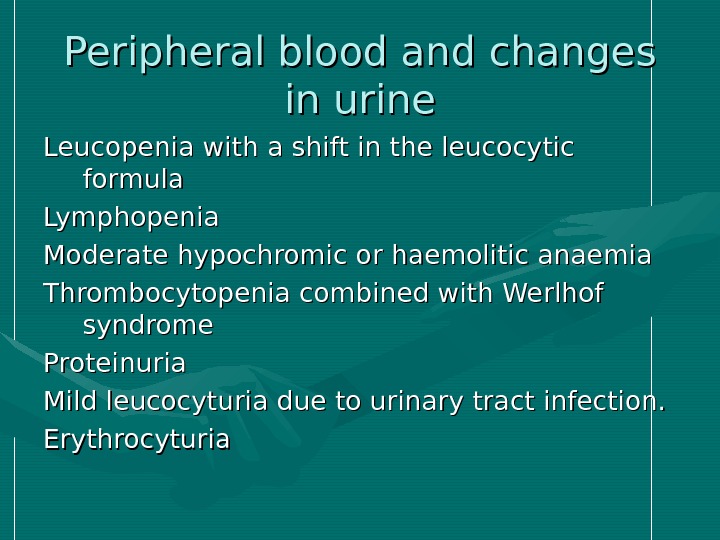
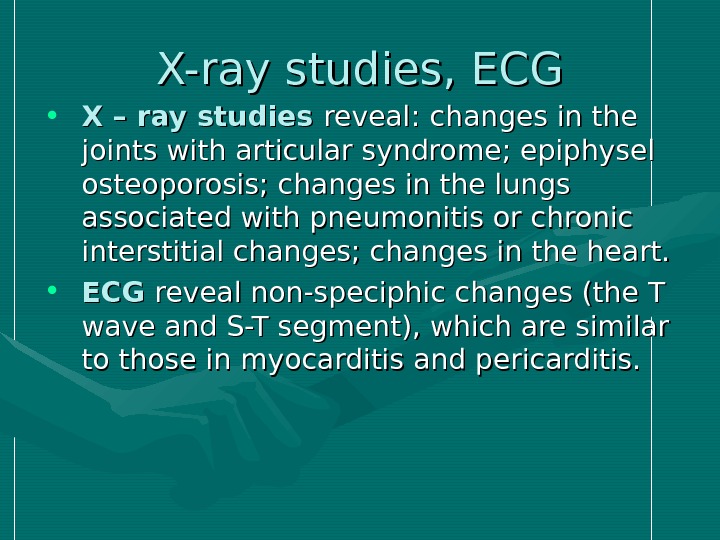

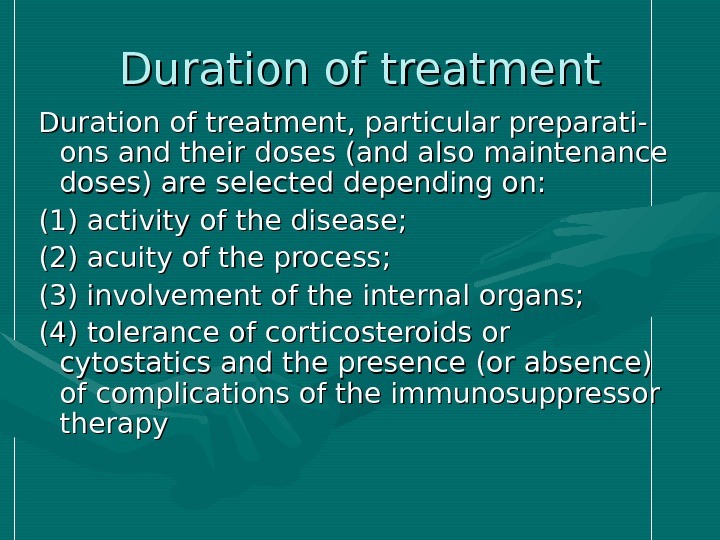



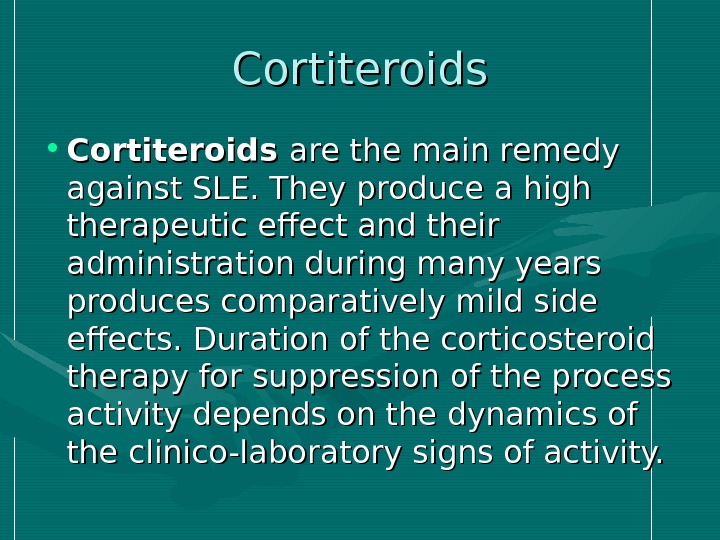
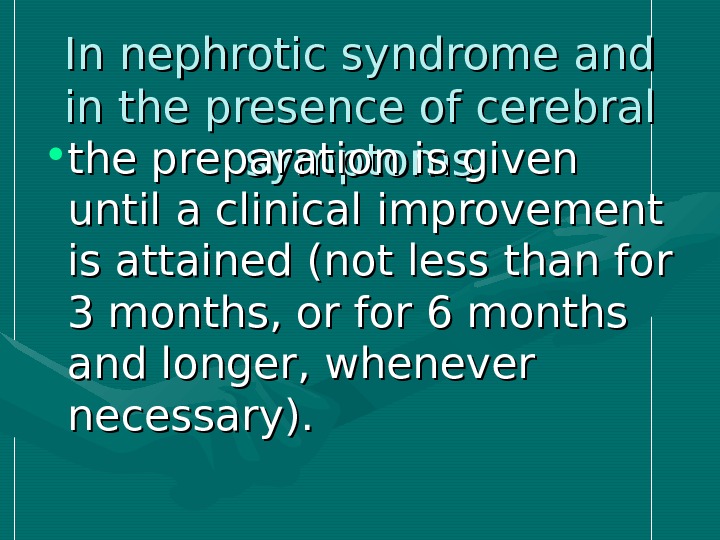
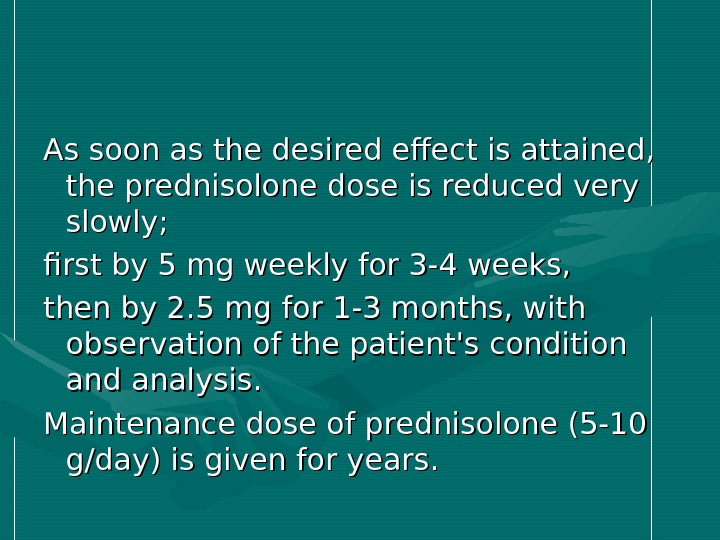
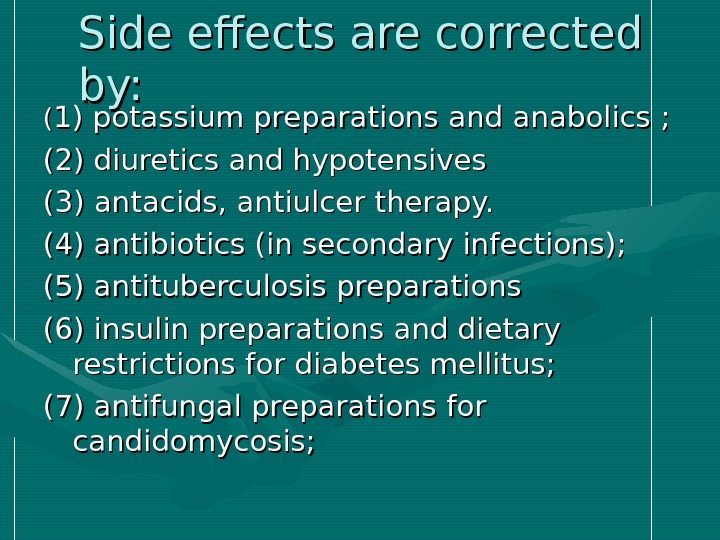
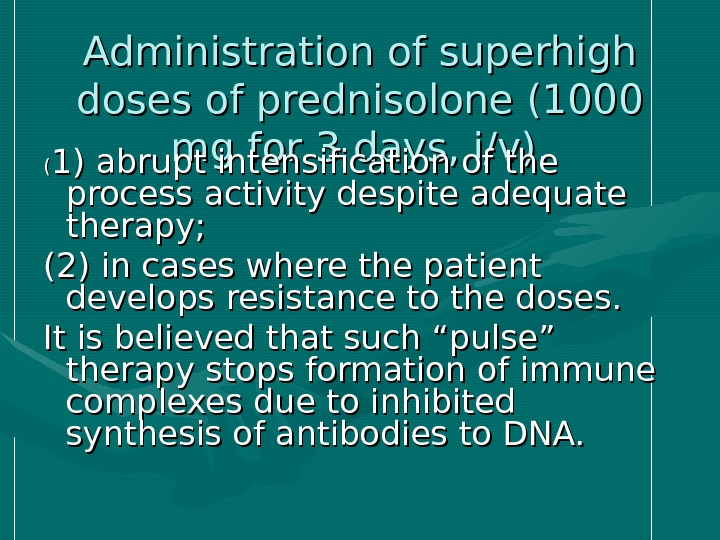
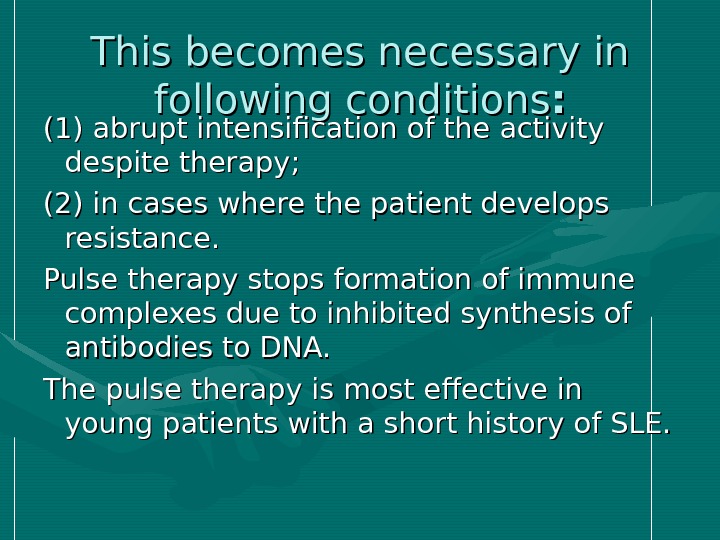
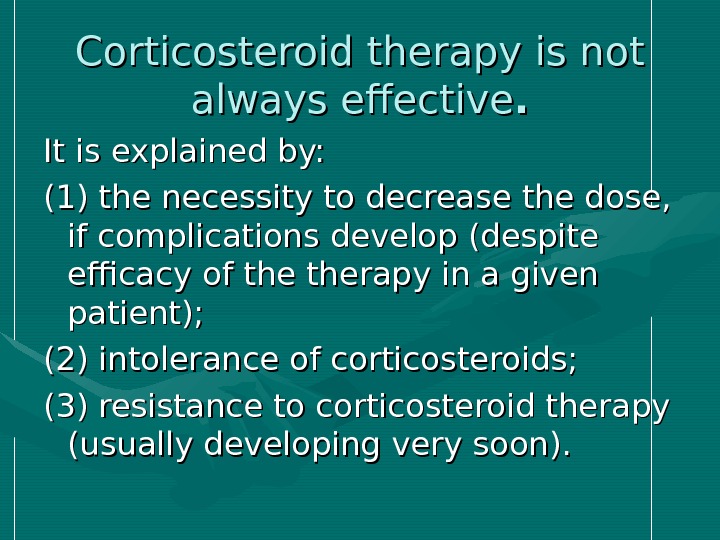
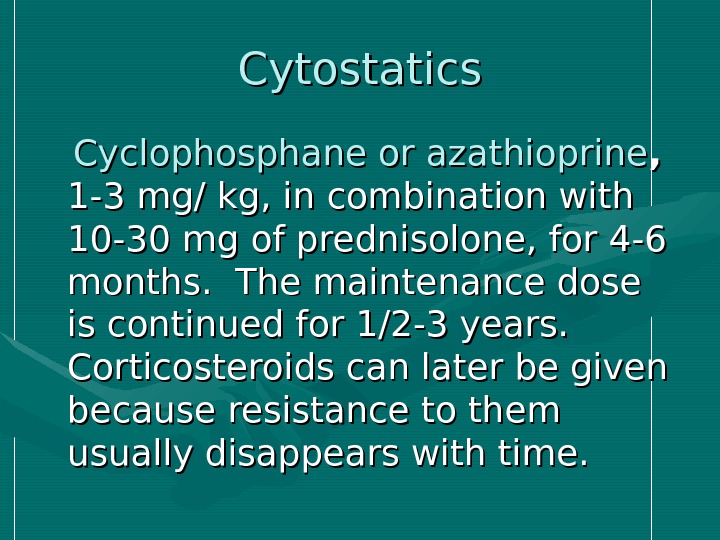
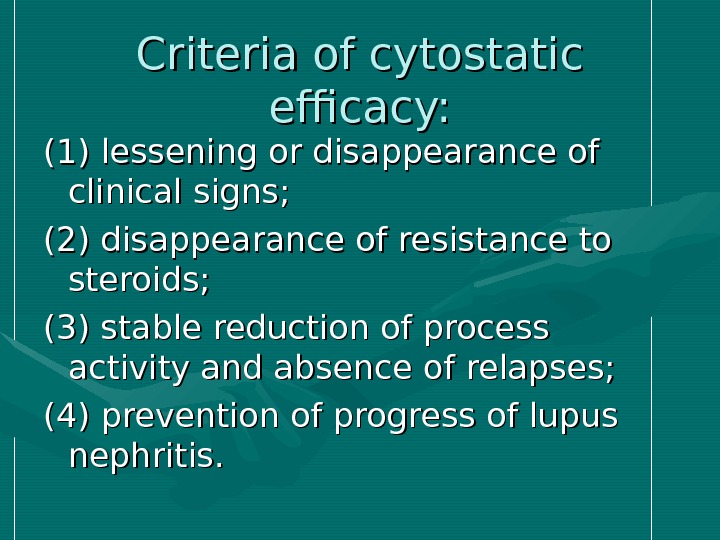
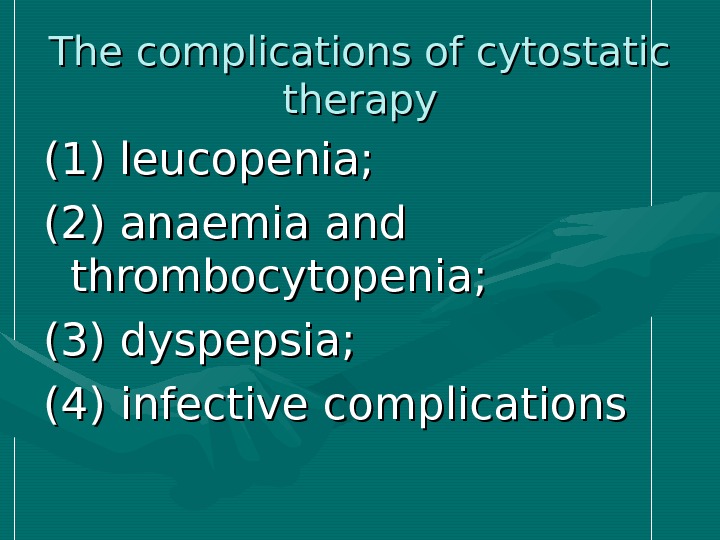
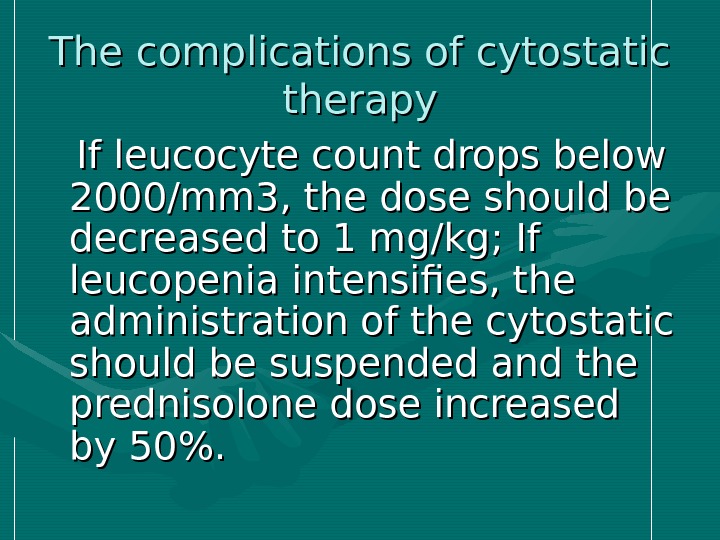
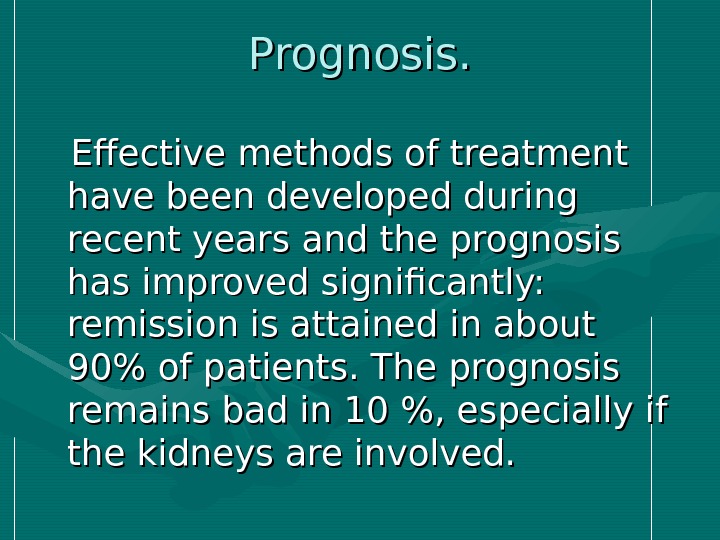
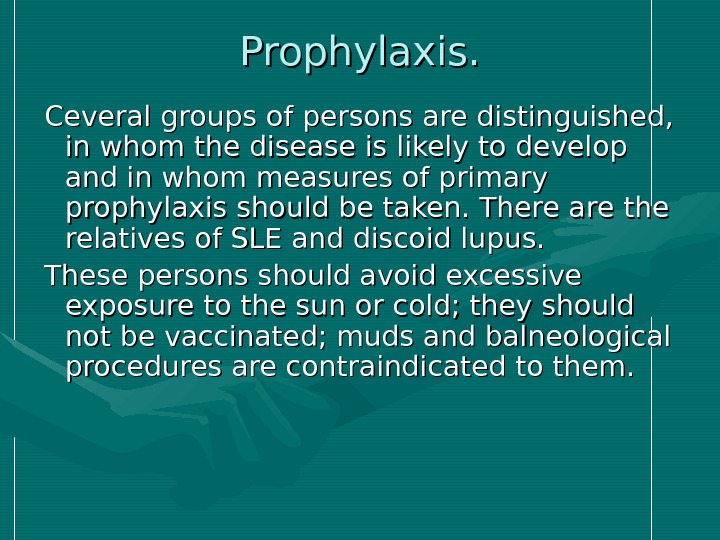
diffuse_diseases_of_cjnnective_tissue.ppt
- Размер: 110.5 Кб
- Количество слайдов: 43
Описание презентации DIFFUSE DISEASES of CONNECTIVE TISSUE (DDCT) Definition по слайдам
 DIFFUSE DISEASES of CONNECTIVE TISSUE (DDCT)
DIFFUSE DISEASES of CONNECTIVE TISSUE (DDCT)
 Definition DDCT (collagen diseases)- are characterized by systemic inflammation of connective tissue and its appendages. This group includes four major collagen diseases: systemic lupus erythematosus, systemic scleroderma, polyarteritis (periarteritis) nodosa, dermatomyositis.
Definition DDCT (collagen diseases)- are characterized by systemic inflammation of connective tissue and its appendages. This group includes four major collagen diseases: systemic lupus erythematosus, systemic scleroderma, polyarteritis (periarteritis) nodosa, dermatomyositis.
 Common features of diseases: 1. common pathogenesis, which is manifested by disordered immune homeostasis and hyperplasia of immunocompetent organs with signs of dysproteinosis. The autoimmune processes play the leading role. Own cells and tissues are assessed by the body as foreign and autoantibodies are produced
Common features of diseases: 1. common pathogenesis, which is manifested by disordered immune homeostasis and hyperplasia of immunocompetent organs with signs of dysproteinosis. The autoimmune processes play the leading role. Own cells and tissues are assessed by the body as foreign and autoantibodies are produced
 2. similarity of morphological changes: fibrinoid changes in connective tissue, vasculitis, lymphoid and plasma cell infiltrates 3. undulant and chronic course 4. exacerbations due to non-specific factors
2. similarity of morphological changes: fibrinoid changes in connective tissue, vasculitis, lymphoid and plasma cell infiltrates 3. undulant and chronic course 4. exacerbations due to non-specific factors
 5. involvement of many systems: joints, skin, heart, kidneys, serous membranes 6. corticosteroids are effective; other anti-inflammatory and immunosuppressive preparations are less efficacious.
5. involvement of many systems: joints, skin, heart, kidneys, serous membranes 6. corticosteroids are effective; other anti-inflammatory and immunosuppressive preparations are less efficacious.
 Risk or predisposing factors • Heredity or genetic factors • Immunological factors • Sex hormone status • Environment triggers: ultraviolet light; a viral agents; drags ( hydralazine, methildopa, procaiamide, D-penicillamine ))
Risk or predisposing factors • Heredity or genetic factors • Immunological factors • Sex hormone status • Environment triggers: ultraviolet light; a viral agents; drags ( hydralazine, methildopa, procaiamide, D-penicillamine ))
 Pathogenesis In the presence of hereditary predisposition the virus upset the immune response which causes hyper-reactivity of the humoral immunity. Antibodies to various tissues, cells, proteins are produced uncontrolled in patient’s body.
Pathogenesis In the presence of hereditary predisposition the virus upset the immune response which causes hyper-reactivity of the humoral immunity. Antibodies to various tissues, cells, proteins are produced uncontrolled in patient’s body.
 The next stage is formation of immune complexes and their deposition in various organs. Then, the processes connected with elimination of fixed immune complexes occur, as a result of which lysosome enzymes are released, organs an tissues are affected, and immune inflammation develops.
The next stage is formation of immune complexes and their deposition in various organs. Then, the processes connected with elimination of fixed immune complexes occur, as a result of which lysosome enzymes are released, organs an tissues are affected, and immune inflammation develops.
 During inflammation and distruction of connective tissue, new antigents are released, in response to which antibodies and new immune complexes are formed. A vicious circle is closed and the disease becomes chronic.
During inflammation and distruction of connective tissue, new antigents are released, in response to which antibodies and new immune complexes are formed. A vicious circle is closed and the disease becomes chronic.
 Systemic lupus erythematosus (SLE) SLE is an inflammatory, multisystem disorder with arthralgia and rashes as the most common clinical features, and cerebral and renal diseases as the most serious problems.
Systemic lupus erythematosus (SLE) SLE is an inflammatory, multisystem disorder with arthralgia and rashes as the most common clinical features, and cerebral and renal diseases as the most serious problems.
 General features Fever is common in exacerbations occurring in up to 50% of cases. Patients complain of marked malaise and tiredness.
General features Fever is common in exacerbations occurring in up to 50% of cases. Patients complain of marked malaise and tiredness.
 The joints (90%) Patients have symptoms that sound like RA with small joints being involved in a symmetrical fashion. Joints are painful, sometimes there is slight soft-tissue swelling surrounding the joint. Deformity due to joint capsule and tendon contraction, bony erosions and aseptic necrosis — are rare. Myalgia is present in up to 50% of patients, but a true myositis in< 5%.
The joints (90%) Patients have symptoms that sound like RA with small joints being involved in a symmetrical fashion. Joints are painful, sometimes there is slight soft-tissue swelling surrounding the joint. Deformity due to joint capsule and tendon contraction, bony erosions and aseptic necrosis — are rare. Myalgia is present in up to 50% of patients, but a true myositis in< 5%.
 The skin (75% of cases) • Erythema in «butterfly» distribution on the cheeks of the face • Vasculitic lesion of the fingertips and around nail-folds, purpura, urticaria • Photosensitivity • Livedo reticularis, palmar and plantar rashes pigmentation • Alopecia
The skin (75% of cases) • Erythema in «butterfly» distribution on the cheeks of the face • Vasculitic lesion of the fingertips and around nail-folds, purpura, urticaria • Photosensitivity • Livedo reticularis, palmar and plantar rashes pigmentation • Alopecia
 The lungs (50%) • Reccurrent pleurisy and pleural effusions (exudates) are bilaterial. • Pneumonitis • Atelectasis • Restrictive lung defect develops with loss of lung volumes. • Pulmonary fibrosis
The lungs (50%) • Reccurrent pleurisy and pleural effusions (exudates) are bilaterial. • Pneumonitis • Atelectasis • Restrictive lung defect develops with loss of lung volumes. • Pulmonary fibrosis
 Heart (25%) • Pericarditis, with small pericardial effusions • A mild myocarditis giving rise to arrhythmias. • Aortic valve lesions • Cardiomyopathy • Non-infective endocarditis involving the mitral valve (Libman-Sacks syndrome) • Vasculitis, arterial and venous thromboses
Heart (25%) • Pericarditis, with small pericardial effusions • A mild myocarditis giving rise to arrhythmias. • Aortic valve lesions • Cardiomyopathy • Non-infective endocarditis involving the mitral valve (Libman-Sacks syndrome) • Vasculitis, arterial and venous thromboses
 The kidneys (40%) • Most types of glomerulonephritis occur: mesangial, focal, diffuse and membranous. • Hypertension • Nephrotic syndrome • Renal failure.
The kidneys (40%) • Most types of glomerulonephritis occur: mesangial, focal, diffuse and membranous. • Hypertension • Nephrotic syndrome • Renal failure.
 The nervous system (60%) • There may be a mild depression • Psychiatric disturbunces • Epilepsy • Cerebellar ataxia • Aseptic meningitis • Cranial nerve lesions • Cerebrovascular accidents • Polyneuropathy
The nervous system (60%) • There may be a mild depression • Psychiatric disturbunces • Epilepsy • Cerebellar ataxia • Aseptic meningitis • Cranial nerve lesions • Cerebrovascular accidents • Polyneuropathy
 The eyes • Retinal vasculitis can cause infarcts, hard exudates and haemorrhages. • Episcleritis, • Conjunctivitis • Optic neuritis, blindness is uncommon. • Secondary Sjogren’s syndrome (15% of cases).
The eyes • Retinal vasculitis can cause infarcts, hard exudates and haemorrhages. • Episcleritis, • Conjunctivitis • Optic neuritis, blindness is uncommon. • Secondary Sjogren’s syndrome (15% of cases).
 The gastrointestinal system • Mesenteric vasculitis can produce inflammatory lesions involving the small bowel (infarction or perforation) • Liver involvement is unusual • Pancreatitis is uncommon
The gastrointestinal system • Mesenteric vasculitis can produce inflammatory lesions involving the small bowel (infarction or perforation) • Liver involvement is unusual • Pancreatitis is uncommon
 LUPUS variants • Chronic discoid lupus is a benign variant. The rash is characteristic and appears on the face as well-defined erythematous plaques that progress to scarring and pigmentation. • Subacute cutaneous lupus erythematosus is a rare variant
LUPUS variants • Chronic discoid lupus is a benign variant. The rash is characteristic and appears on the face as well-defined erythematous plaques that progress to scarring and pigmentation. • Subacute cutaneous lupus erythematosus is a rare variant
 Drug-induced SLE • Drug-induced SLE is is characterized by arthralgia and mild systemic features, rashes and pericarditis, but seldom renal or cerebral disease. It usually disappears when the drug is stopped. Hydralazine, procianamide are the most likely causes.
Drug-induced SLE • Drug-induced SLE is is characterized by arthralgia and mild systemic features, rashes and pericarditis, but seldom renal or cerebral disease. It usually disappears when the drug is stopped. Hydralazine, procianamide are the most likely causes.
 Findings of direct diagnostic importance : : • LE-cells are mature neutrophils that have phagocytized nuclear protein of cells destroyed by the antinuclear factor (AF) • AF a complex of antinuclear antibodies circulating in the blood in high titres ≥≥ 1: 32 • Antibodies to native (whole) DNA • The rosette phenomenon: free-lying lyised nuclei in tissues (bodies of acute phase).
Findings of direct diagnostic importance : : • LE-cells are mature neutrophils that have phagocytized nuclear protein of cells destroyed by the antinuclear factor (AF) • AF a complex of antinuclear antibodies circulating in the blood in high titres ≥≥ 1: 32 • Antibodies to native (whole) DNA • The rosette phenomenon: free-lying lyised nuclei in tissues (bodies of acute phase).
 Non-specific sings of acute phase: • Dysproteinemia with high alpha 2 and gamma — globulin content • Appearance of C-reactive protein • High fibrinogen content • Accelerated ESR • The rheumatoid factor (antibody to the Fc fragment of class G immune globulin)
Non-specific sings of acute phase: • Dysproteinemia with high alpha 2 and gamma — globulin content • Appearance of C-reactive protein • High fibrinogen content • Accelerated ESR • The rheumatoid factor (antibody to the Fc fragment of class G immune globulin)
 Peripheral blood and changes in urine Leucopenia with a shift in the leucocytic formula Lymphopenia Moderate hypochromic or haemolitic anaemia Thrombocytopenia combined with Werlhof syndrome Proteinuria Mild leucocyturia due to urinary tract infection. Erythrocyturia
Peripheral blood and changes in urine Leucopenia with a shift in the leucocytic formula Lymphopenia Moderate hypochromic or haemolitic anaemia Thrombocytopenia combined with Werlhof syndrome Proteinuria Mild leucocyturia due to urinary tract infection. Erythrocyturia
 X-ray studies, ECG • X – ray studies reveal: changes in the joints with articular syndrome; epiphysel osteoporosis; changes in the lungs associated with pneumonitis or chronic interstitial changes; changes in the heart. • ECG reveal non-speciphic changes (the T wave and S-T segment), which are similar to those in myocarditis and pericarditis.
X-ray studies, ECG • X – ray studies reveal: changes in the joints with articular syndrome; epiphysel osteoporosis; changes in the lungs associated with pneumonitis or chronic interstitial changes; changes in the heart. • ECG reveal non-speciphic changes (the T wave and S-T segment), which are similar to those in myocarditis and pericarditis.
 Management Complex pathogenetic therapy is indicated: (1) suppression of immune inflammation and immune complex pathology (2) action on separate pronounced syndrom. (3) prevention of side effects of immunosup- pressive therapy (4) treatment of complications of therapy.
Management Complex pathogenetic therapy is indicated: (1) suppression of immune inflammation and immune complex pathology (2) action on separate pronounced syndrom. (3) prevention of side effects of immunosup- pressive therapy (4) treatment of complications of therapy.
 Duration of treatment, particular preparati- ons and their doses (and also maintenance doses) are selected depending on: (1) activity of the disease; (2) acuity of the process; (3) involvement of the internal organs; (4) tolerance of corticosteroids or cytostatics and the presence (or absence) of complications of the immunosuppressor therapy
Duration of treatment, particular preparati- ons and their doses (and also maintenance doses) are selected depending on: (1) activity of the disease; (2) acuity of the process; (3) involvement of the internal organs; (4) tolerance of corticosteroids or cytostatics and the presence (or absence) of complications of the immunosuppressor therapy
 In subacute and chronic course: • non-steroid anti-inflammatory preparati- ons: salicylates – aspirin 1 — 4 times a day; • derivatives of pyrozoloni (amidopyrini 0, 25 4 times a day, analgini 0, 5 4 times a day); • derivatives of indoli (indomethacin 25 – 60 mg 3 times a day); • brufen 2 dr 3 times a day.
In subacute and chronic course: • non-steroid anti-inflammatory preparati- ons: salicylates – aspirin 1 — 4 times a day; • derivatives of pyrozoloni (amidopyrini 0, 25 4 times a day, analgini 0, 5 4 times a day); • derivatives of indoli (indomethacin 25 – 60 mg 3 times a day); • brufen 2 dr 3 times a day.
 In chronic course: • In chronic course with predominant involment of the skin : : delagil, chloroquine 0, 25 – 0, 5 g 3 times a day for 2 weeks, then 0, 25 1 times a day for many months.
In chronic course: • In chronic course with predominant involment of the skin : : delagil, chloroquine 0, 25 – 0, 5 g 3 times a day for 2 weeks, then 0, 25 1 times a day for many months.
 In acute and subacute course or if the sings of generalization • should be given prednisolone: in acute course and third degree 40 -60 mg; in the activity of the second degree 30 -40 mg; and in first degree 15 -20 mg. Maintenance doses are 5 or 10 mg daily.
In acute and subacute course or if the sings of generalization • should be given prednisolone: in acute course and third degree 40 -60 mg; in the activity of the second degree 30 -40 mg; and in first degree 15 -20 mg. Maintenance doses are 5 or 10 mg daily.
 Cortiteroids • Cortiteroids are the main remedy against SLE. They produce a high therapeutic effect and their administration during many years produces comparatively mild side effects. Duration of the corticosteroid therapy for suppression of the process activity depends on the dynamics of the clinico-laboratory signs of activity.
Cortiteroids • Cortiteroids are the main remedy against SLE. They produce a high therapeutic effect and their administration during many years produces comparatively mild side effects. Duration of the corticosteroid therapy for suppression of the process activity depends on the dynamics of the clinico-laboratory signs of activity.
 In nephrotic syndrome and in the presence of cerebral symptoms • the preparation is given until a clinical improvement is attained (not less than for 3 months, or for 6 months and longer, whenever necessary).
In nephrotic syndrome and in the presence of cerebral symptoms • the preparation is given until a clinical improvement is attained (not less than for 3 months, or for 6 months and longer, whenever necessary).
 As soon as the desired effect is attained, the prednisolone dose is reduced very slowly; first by 5 mg weekly for 3 -4 weeks, then by 2. 5 mg for 1 -3 months, with observation of the patient’s condition and analysis. Maintenance dose of prednisolone (5 -10 g/day) is given for years.
As soon as the desired effect is attained, the prednisolone dose is reduced very slowly; first by 5 mg weekly for 3 -4 weeks, then by 2. 5 mg for 1 -3 months, with observation of the patient’s condition and analysis. Maintenance dose of prednisolone (5 -10 g/day) is given for years.
 Side effects are corrected by: (( 1) potassium preparations and anabolics ; (2) diuretics and hypotensives (3) antacids, antiulcer therapy. (4) antibiotics (in secondary infections); (5) antituberculosis preparations (6) insulin preparations and dietary restrictions for diabetes mellitus; (7) antifungal preparations for candidomycosis;
Side effects are corrected by: (( 1) potassium preparations and anabolics ; (2) diuretics and hypotensives (3) antacids, antiulcer therapy. (4) antibiotics (in secondary infections); (5) antituberculosis preparations (6) insulin preparations and dietary restrictions for diabetes mellitus; (7) antifungal preparations for candidomycosis;
 Administration of superhigh doses of prednisolone (1000 mg for 3 days, i/v). (( 1) abrupt intensification of the process activity despite adequate therapy; (2) in cases where the patient develops resistance to the doses. It is believed that such “pulse” therapy stops formation of immune complexes due to inhibited synthesis of antibodies to DNA.
Administration of superhigh doses of prednisolone (1000 mg for 3 days, i/v). (( 1) abrupt intensification of the process activity despite adequate therapy; (2) in cases where the patient develops resistance to the doses. It is believed that such “pulse” therapy stops formation of immune complexes due to inhibited synthesis of antibodies to DNA.
 This becomes necessary in following conditions : : (1) abrupt intensification of the activity despite therapy; (2) in cases where the patient develops resistance. Pulse therapy stops formation of immune complexes due to inhibited synthesis of antibodies to DNA. The pulse therapy is most effective in young patients with a short history of SLE.
This becomes necessary in following conditions : : (1) abrupt intensification of the activity despite therapy; (2) in cases where the patient develops resistance. Pulse therapy stops formation of immune complexes due to inhibited synthesis of antibodies to DNA. The pulse therapy is most effective in young patients with a short history of SLE.
 Corticosteroid therapy is not always effective. . It is explained by: (1) the necessity to decrease the dose, if complications develop (despite efficacy of the therapy in a given patient); (2) intolerance of corticosteroids; (3) resistance to corticosteroid therapy (usually developing very soon).
Corticosteroid therapy is not always effective. . It is explained by: (1) the necessity to decrease the dose, if complications develop (despite efficacy of the therapy in a given patient); (2) intolerance of corticosteroids; (3) resistance to corticosteroid therapy (usually developing very soon).
 Cytostatics Cyclophosphane or azathioprine , , 1 -3 mg/ kg, in combination with 10 -30 mg of prednisolone, for 4 -6 months. The maintenance dose is continued for 1/2 -3 years. Corticosteroids can later be given because resistance to them usually disappears with time.
Cytostatics Cyclophosphane or azathioprine , , 1 -3 mg/ kg, in combination with 10 -30 mg of prednisolone, for 4 -6 months. The maintenance dose is continued for 1/2 -3 years. Corticosteroids can later be given because resistance to them usually disappears with time.
 Criteria of cytostatic efficacy: (1) lessening or disappearance of clinical signs; (2) disappearance of resistance to steroids; (3) stable reduction of process activity and absence of relapses; (4) prevention of progress of lupus nephritis.
Criteria of cytostatic efficacy: (1) lessening or disappearance of clinical signs; (2) disappearance of resistance to steroids; (3) stable reduction of process activity and absence of relapses; (4) prevention of progress of lupus nephritis.
 The complications of cytostatic therapy (1) leucopenia; (2) anaemia and thrombocytopenia; (3) dyspepsia; (4) infective complications
The complications of cytostatic therapy (1) leucopenia; (2) anaemia and thrombocytopenia; (3) dyspepsia; (4) infective complications
 The complications of cytostatic therapy If leucocyte count drops below 2000/mm 3, the dose should be decreased to 1 mg/kg; If leucopenia intensifies, the administration of the cytostatic should be suspended and the prednisolone dose increased by 50%.
The complications of cytostatic therapy If leucocyte count drops below 2000/mm 3, the dose should be decreased to 1 mg/kg; If leucopenia intensifies, the administration of the cytostatic should be suspended and the prednisolone dose increased by 50%.
 Prognosis. Effective methods of treatment have been developed during recent years and the prognosis has improved significantly: remission is attained in about 90% of patients. The prognosis remains bad in 10 %, especially if the kidneys are involved.
Prognosis. Effective methods of treatment have been developed during recent years and the prognosis has improved significantly: remission is attained in about 90% of patients. The prognosis remains bad in 10 %, especially if the kidneys are involved.
 Prophylaxis. Ceveral groups of persons are distinguished, in whom the disease is likely to develop and in whom measures of primary prophylaxis should be taken. There are the relatives of SLE and discoid lupus. These persons should avoid excessive exposure to the sun or cold; they should not be vaccinated; muds and balneological procedures are contraindicated to them.
Prophylaxis. Ceveral groups of persons are distinguished, in whom the disease is likely to develop and in whom measures of primary prophylaxis should be taken. There are the relatives of SLE and discoid lupus. These persons should avoid excessive exposure to the sun or cold; they should not be vaccinated; muds and balneological procedures are contraindicated to them.

